






Horrocks
HMB
RDA










by Larry Smith, Jr., PE, LEED Green Associate
When the Trilon Transportation Platform was established, we envisioned a dynamic and collaborative business model that would bring together the best talent in the industry, and our collective resources, to exceed our clients’ expectations. Our ability to collaborate on many projects by pooling our expertise and resources has not only advanced us as a platform but each of our partner firms.
In this issue of Braking News, we showcase how our platform partner firms are leveraging various technologies – from Geographic Information Systems (GIS) and drone modeling to digital deliverables and transparent noise barrier walls – all to deliver better client experiences and project outcomes.
With the growing demand for transportation engineering services, our clients seek effectiveness, sustainability, and efficiency. Maximizing the latest technology is essential to meeting and exceeding these expectations.
I encourage you to take the time to explore each firm’s contributions and discover the services, innovations, and practical resources they offer. These insights could have a significant positive impact on your work, providing solutions for your clients and service areas.
Let’s continue to build momentum and capitalize on our collaboration and investment in technology to help us achieve better outcomes for our clients and success for our platform.
Our Trilon transportation platform firms are leading the way in innovation, using advanced technology to deliver projects more efficiently and creatively to exceed client expectations.
From HMB Professional Engineers designing Kentucky’s first transparent noise barrier to DRMP using ProjectWise, and from RDA’s drones and 3D modeling to Horrocks’ groundbreaking GIS applications, our firms are keeping pace with the latest technology. Meanwhile, Alta is stepping up the game in digital delivery by tapping into tools that make data more interactive and meaningful for clients. We’re not just redefining how we serve our clients and elevating project outcomes; we’re raising the bar on transportation consulting.
HMB Designs Kentucky’s First Transparent Noise Screening Barrier Panel
One example of this clientcentered innovation is Kentucky’s first transparent noise screening barrier installed along Crescent Avenue in Covington. This groundbreaking pilot project, overseen by the Kentucky Transportation Cabinet (KYTC), evaluates see-through noise barriers while preserving scenic views.
HMB Professional Engineers, the
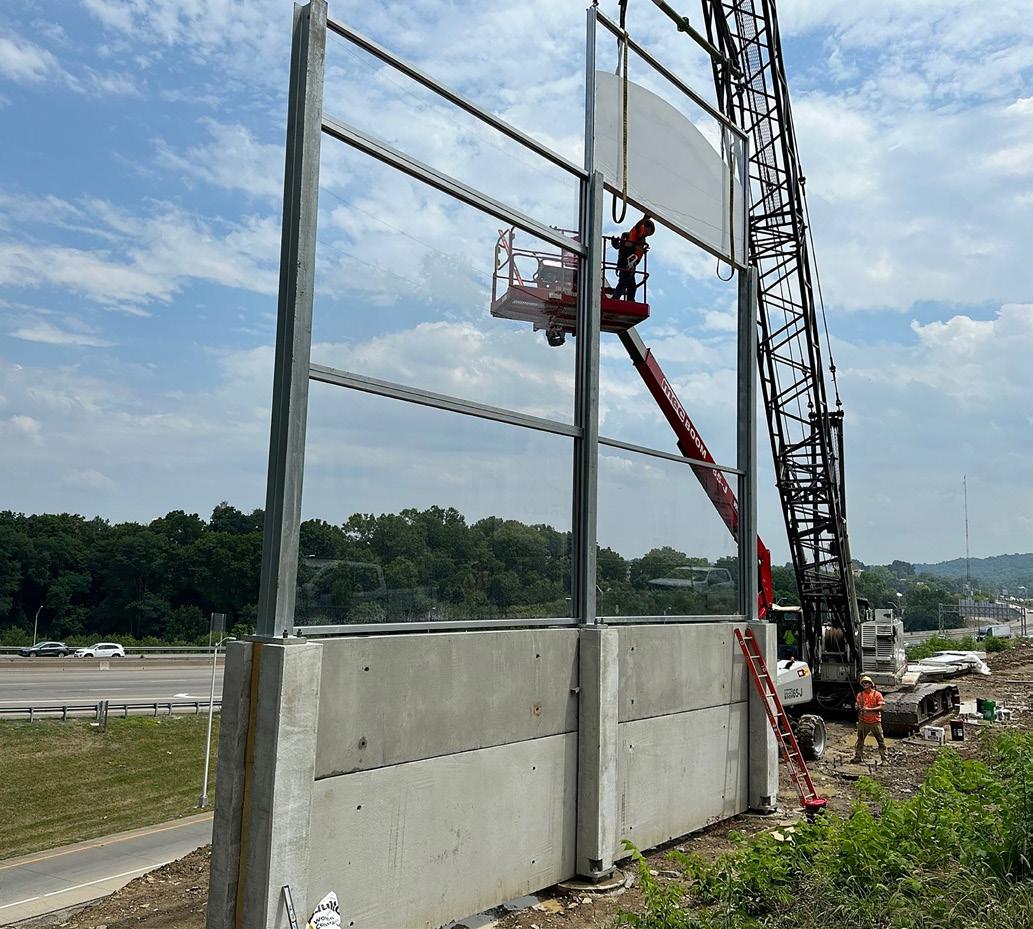

environmental consultant for the project, designed these noise walls, emphasizing innovative and community-focused engineering solutions. The project, initiated in November 2023, is located just west of Interstates 71 and 75 (I-71/75). Transparent materials are being used along a 1,000foot stretch to reduce highway noise without obstructing views of downtown Cincinnati and the Ohio River.
Public feedback highlighted the importance of maintaining scenic vistas, transforming the work into a pilot project. This initiative allows Covington residents and businesses to experience how well transparent noise walls perform in reducing highway noise while preserving sight lines to the city skyline and beyond.
“Of course, everyone is concerned with noise, but
In addition to physical infrastructure, our partner firms are streamlining workflows and enhancing collaboration through digital tools. DRMP, for instance,
they’re also concerned with the loss of views in the area, particularly from Goebel Park and from the west side of the interstate looking toward the Cincinnati skyline or the Covington-Mainstrasse area,” said Gary Valentine, KYTC’s BSBC major project coordinator. “We heard that, so we started kicking around the idea of transparent noise barriers.”
Clear barriers have long been used in coastal states and Europe, and recently in Ohio and Tennessee. This project marks Kentucky’s first use of the concept. Expected to be completed in October 2024, the pilot project will inform future decisions on their use along the I-75 corridor.
HMB Professional Engineers’ involvement from the project’s inception highlights its role in bringing innovative technological solutions to the community. The pilot project will provide valuable feedback to KYTC on the effectiveness of transparent noise barriers in enhancing both the acoustic and visual environment of Covington.
is optimizing project delivery using ProjectWise, a Bentley Systems product hosted on Microsoft Azure.
This program offers a shared network for managing files and collaborating. ProjectWise Explorer functions much like
Windows Explorer but is designed for file sharing, management, and real-time collaboration. With ProjectWise, DRMP’s subconsultants always have access to the most current files.
“The benefit to subconsultants that work directly with us is that the files are always live for anyone working on the project", said DRMP Roadway Engineer Steven D’Uva, PE. "No more zipping files with transmittal emails/ additional file sharing software. No more out-of-date files as references in CADD software.”
Files are cached locally and only updated when changes occur, which minimizes unnecessary data transfers and keeps the firm’s work streamlined.
ProjectWise Drive, similar to OneDrive, Sharepoint, and Dropbox, integrates with Windows Explorer, allowing non-CADD (Computer-Aided Drafting & Design) staff to easily sync files and collaborate. While primarily used by the Marketing and Alternative Delivery teams, it’s also recommended for the firm’s CADD staff and subconsultants, especially for workspaces, such as the Florida Department of Transportations’ (FDOT)
workspace for OpenRoads.
For web-based access, Projectwise365/ Infrastructure Cloud connects users to the shared server, enabling file sharing, comments, and reviews. It supports iTwin and iModel services for detailed 3D model inspections, facilitating effective collaboration and issue resolution, which is increasingly favored by DRMP’s FDOT clients.
“Our lives are becoming easier and more streamlined by migrating our file management and day-to-day work from the old school local servers to the more state-of-the-art shared cloud-based files/ resources," said DRMP Roadway Engineer Stephen Donegan, PE. “And it makes a world of difference to ensure that we are continually referencing subconsultants’ latest greatest data (and vice versa).”
The transition to cloud-based file management has streamlined DRMP’s processes, enhancing cross-office collaboration, even across state lines. This shift is especially significant as the firm also embraces Autodesk Construction Cloud (ACC) for projects using AutoCAD formats. ACC, like ProjectWise, hosts files in the cloud, caches them locally, and updates changes efficiently.
Leveraging advanced technology isn’t just about improving internal processes—it’s also about delivering better results for clients. RDA’s use of drones and 3D modeling demonstrates this commitment.
Over the last five years, RDA has increasingly used drone footage to maximize design and marketing opportunities from project scoping to finished construction. Drone imagery has been used for marketing materials,
documentation purposes, and more interestingly, used in cases where survey/existing aerial imagery is not available or current. Quick site visits with a drone have allowed RDA to capture a few hundred photos and turn that data into large scale stitched orthoimagery and terrain data available for reference into RDA’s CADD software for conceptual designs. This not only reduces costs associated with a full survey but allows the firm to capture current information
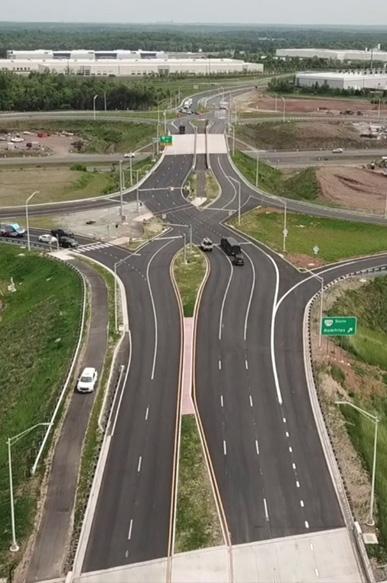

Horrocks Applies GIS Analytics for Cutting-Edge Applications
Our firms are advancing data analytics and GIS to develop smarter infrastructure solutions. Horrocks is leading with innovative GIS applications that enhance decision-making and go beyond traditional data management and visualization.
Today, GIS is the preferred tool for gathering, storing, and presenting data in the civil engineering market. However, most civil engineering firms are only using GIS for data management and visualization, ignoring the analytics side of GIS.
in many pursuits, showing RDA’s commitment to go above and beyond for its client.
Once projects start construction, drone footage has proved invaluable for documentation and marketing opportunities showing the progression of work. Several projects designed by RDA have been flown prior to construction to document existing conditions, during construction as work progresses, and after construction completes, while all being captured from the same vantage points. Preflight visualizations can be seen with drone plug-ins and Google Earth, aiding the pre-construction flight paths when projects venture through fields or heavily wooded areas with little reference points.
Horrocks Innovative Technology Solutions Director Derrick Sharp, GISP, explains, “There’s a disconnect in our industry between the analytics side, and data management and visualization.” Sharp is bridging this gap by using GIS to create innovative applications for infrastructure development. These tools include everything from municipal pavement planning applications to robust field data collection helping DOTs to analyze construction data in near real time and integrate with business systems.
In New Mexico, Horrocks was awarded a contract in 2022 on the feasibility and sequencing of various wildlife crossings on US 550. Most firms would use GIS to
store and then map out the data to simply visualize the project. Sharp took it a step further and built out a model on elk migration to analyze how successful the wildlife crossing would be. “It’s a map-based problem,” he said. “And GIS is the perfect tool for analyzing and finding the optimum solution.”
“The use of modern spatial analysis, spatial statistics, and spatial ML models will greatly enhance the engineering decision process. When we can integrate the design process and tools with advanced spatial analytics, we’ll be able to make decisions with a greater understanding of the problems and proposed solutions," Sharp said.

Giving clients the ability to directly interact with insights about transportation in their regions through apps and maps is one of the next frontiers. Alta’s Civic Analytics team is developing tools that reflect our values. Examples of new digital delivery across the data lifecycle include:
Many jurisdictions are struggling to manage a comprehensive view of their assets. Alta develops Geographic Information System (GIS) tools that bring together data
Sharp credits much of his innovative thinking to his past research. While studying for his Masters in Geographically Integrated History, he used GIS to build machine learning applications that studied how severe weather patterns impacted the diamond and wine smuggling trade between Brazil and Portugal from 1600-1850. This background has helped Sharp look at civil engineering problems with fresh eyes and create new tools where solutions don’t already exist.
across jurisdictions to visualize and catalogue active transportation data facilities throughout the Metropolitan Planning Organization (MPO). This will help the region understand how to make investments to complete multimodal networks and other decisions such as maintenance.
Alta is bringing together data from different sources through partnerships with data providers to amplify the impact of infrastructure work. This is exemplified by a partnership between Alta, Replica, and Heavy. AI to Evaluate The Portion Of Trips On Major U.S. Bridges being made by disadvantaged communities nationwide.
Clients are increasingly asking for data insights that they can access over a web
browser (data dashboard) to examine investment trade-offs. Alta created a budgeted prioritization tool for Kansas City Public Works that allows City staff to see how community priorities for equity and safety are met with different funding options. The tool also makes it possible for Public Works staff to produce lists of sidewalk capital improvement projects that reflect the priorities of Kansas City while meeting the specific requirements and timelines of funding programs that vary in purpose.
Data tells a story. Alta is creating digital deliverables that allow clients, decision makers, stakeholders, and the public to experience data in a way that has meaning to them. This includes:
· Data Story Maps such as the MNDOT Vulnerable User Assessment that distills the plan into a digital executive summary that people can explore online
· Flow maps that show who and how people are moving to make it easier to understand and use the data to prioritize
recommendations. This Map for Hennepin Avenue in Minnesota shows trips that cross the bridge based on the census block group, so that data specifically for equity populations can be analyzed in conjunction with overall population needs
· Compelling Safety Dashboards that provide the most important data at a glance to help people make decisions
For the Tuscon Mobility Plan, the final plan includes a website that tells the plan story from guiding principles through public engagement to recommendations and implementation. Importantly, this format ensures that City staff can easily maintain the site over time and navigate recommendations to identify projects to implement as specific funding becomes available.
As we push the boundaries of transportation consulting through digital delivery, Alta is excited to partner with Trilon in the GIS Center of Excellence to advance these groundbreaking efforts even further.
Welcome to TrilonU! A dynamic learning community aimed to support the growth of our Family of Companies. Looking for resources to advance your career or wanting to build connections with Peers and Leadership? TrilonU has programs and resources designed to help:




By Tony Curtis, PE
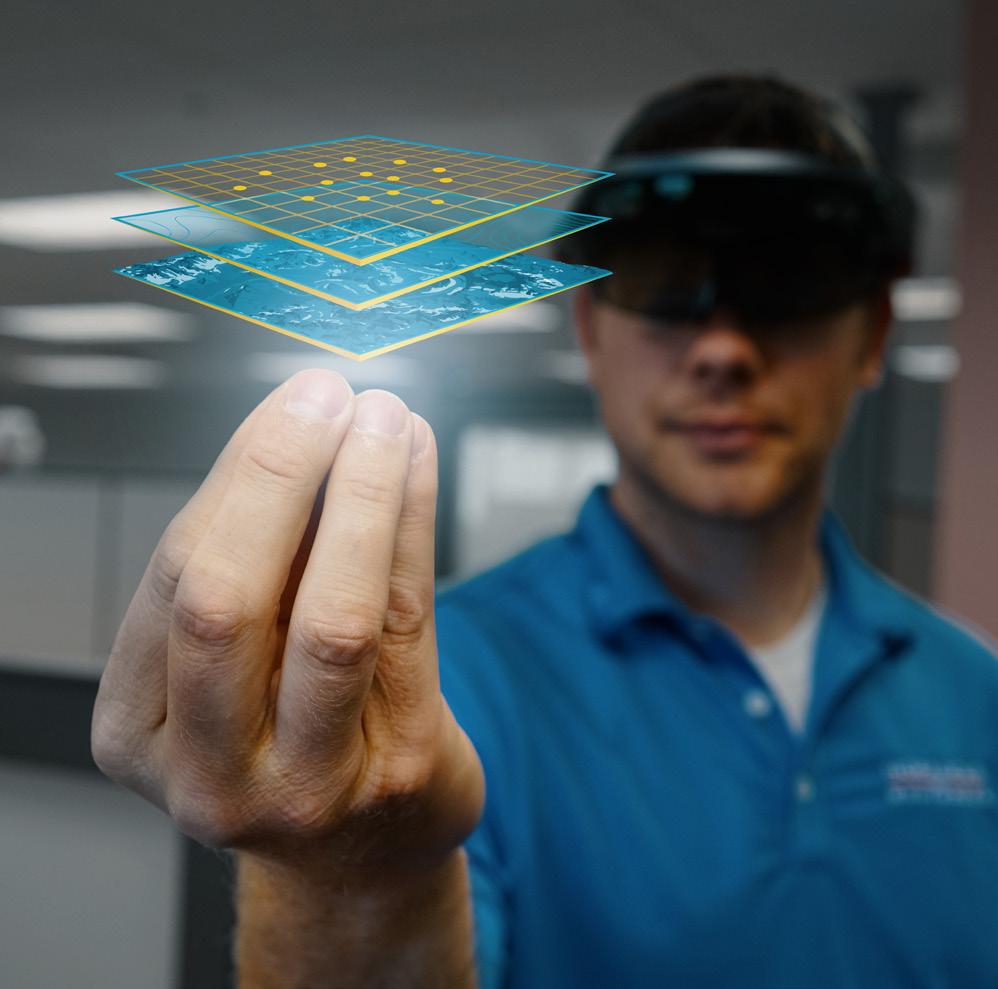
For decades, civil engineering firms have delivered plans the same way: The Computer-Aided Design and Drafting (CADD) team spends weeks making annotations and sheets, followed by a massive Quality Control (QC) process and a frantic print deadline. It’s time-consuming, outdated, and results in difficult or unusable data down the road. That’s where digital delivery comes in.
The average AEC firm collects 2.5 times more data than most industries (Source: Coruzant), but 96 percent of it is unused and 90 percent is unstructured (Source: FMI). Digital delivery provides a better experience by improving access to data, allowing both consultant and client to leverage that data for project analytics and increased efficiency.
At Horrocks, we’re embracing digital delivery to better serve our clients and increase efficiency. Instead of a circular
process of printing sheets and interpreting annotated changes from the contractor and client, digital delivery allows the reviewer to import the full 3D CADD model directly into their own software. Digital tools are used out in the field during construction, further streamlining the process and giving the client more access to data than before.
Our team couldn’t just stop at digital CADD delivery and looked for new ways to leverage technology to improve our clients’ experience. With that mindset, we partnered with Esri to co-market our digital delivery services to Departments of Transportation (DOTs) nationwide and expand digital delivery to include tailored next-generation services.
For the Utah DOT, we created a tool to validate CADD submissions and helped develop standards for utility and hydrology projects. We also provided tools to convert design models into various formats, including:
• Data Sharing with Contractors: We simplified data import and export, enabling contractors to easily access essential information with various software modeling tools
• Collaboration with Inspectors: We created custom digital apps for inspectors to efficiently manage data, integrate workflows, and support tasks like mapping and payment processing
• Managing As-Builts: Our solutions enabled the seamless transfer of contractor as-built data to

UDOT’s systems, supporting enterprise resource planning, Federal Highway Administration (FHWA) reporting, and asset management
In Georgia, we have partnered with Timmons to assist the Georgia DOT in creating processes and tools designed to streamline the collection, storage, and analysis of utility data—both from the DOT and third-party utilities—located in the right-of-way areas.
For the Texas DOT, we’re developing CADD standards and digital specifications for Texas DOT to improve project workflows. Our team supports pilot projects there and leads workgroups on Utility Management,
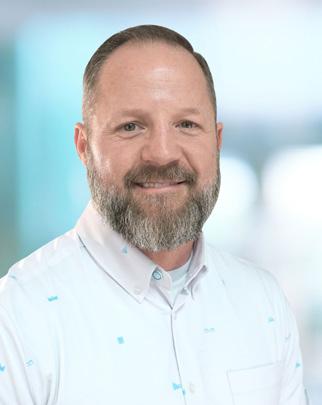
Chief Technology Officer TonyC@horrocks.com
Hydrology, Data Governance, and Digital Delivery. We also write specifications for digital as-builts that all projects meet high standards for accuracy and compliance.
In Iowa, we’re setting standards for OpenRoads Designer (ORD) and CADD for utility and sign projects. We’re also leading efforts to ensure seamless data integration between project and enterprise systems.
If you’d like to learn more about Digital Delivery, feel free to reach out to Tony Curtis here at Horrocks. Together, we can discover new and innovative ways to leverage this technology and give us all more access to the data that will help us improve the work we do and make an even bigger difference in the communities we serve.
Tony has 12 plus years of experience in civil engineering, starting as a Structures Design Engineer and working his way through project management and program management. His structural experience ranges from hydraulic structures and buildings to complicated bridges and includes working with timber, masonry, concrete and steel. Throughout his career, Tony has looked to technology to improve efficiency, enhance user experience, and drive value for our clients and Horrocks. As Horrocks Chief Technology Officer, Tony continues to serve as a bridge between technology and project delivery by leading the overall technology approach and keeping Horrocks at the front of industry trends.


By: Trevor Youd, PE
The I-15 Springville/Spanish Fork Interchange project involved realigning frontage roads, constructing a diamond interchange, widening 1600 S and adding a grade separation over Union Pacific Railroad (UPRR). This was the first Utah Department of Transportation (UDOT) project in Region 3 to use digital delivery, and the largest digital delivery project for UDOT at the time of completion -- marking another milestone in adoption of this new technology across the state.
UDOT had an ongoing contract with Derrick Sharp, GISP, and his team to

develop tools and set up their digital delivery webpage to help standardize this process and provide training for other industry partners. With our previous experience and UDOT’s desire to advance their program, we submitted a proposal that leveraged digital delivery. UDOT selected Horrocks as the prime for the project.
With digital delivery still new to our client, we had to plan for the project a bit differently than we would traditionally. The following are a few key takeaways:
• Get buy-in at the start by setting expectations for both the challenges and benefits of being an early adopter
Pay special attention to organization with the increased number of digital files
Plan for additional meetings/trainings to help educate stakeholders and contractors on how to use digital delivery tools
• Extend bidding window if possible to allow the bidders adequate time to familiarize themselves with the digital files
• Have a designer on board for RFIs (Request for Information) during construction
Listening to the Client: Digital, Traditional, or Hybrid?
Not everyone is open to being an early adopter, so our job is to listen to the clients and adapt our methodology accordingly.

Trevor Youd, PE
Transportation
This project also involved UPRR, and we knew that they would require traditional pdf plans for elements related to the bridge crossing over their tracks. With that in mind, we adopted a hybrid model where everything used digital delivery aside from the structure’s plans, to guarantee project success.
It was exciting to use digital delivery for a larger scale project and to pave the way for successful digital delivery projects in the future. At the end of the project, it was especially nice knowing that UDOT would have a wealth of data to draw from to help it better manage and maintain its new asset far into the future.
Project Manager
TrevorY@horrocks.com
Trevor is a transportation project manager with 15 years of industry experience. He has spent most of his time working on large projects in Utah and New Mexico. He has helped the DOTs in these states deliver projects using a variety of delivery methods, including traditional and digital delivery for design-bid-build, design-build program management, and progressive design-build projects.

by Brett Hondorp, AICP
Safety is a year-round theme at Alta, but especially important during the fall and back-to-school season when more kids are out and days are getting shorter. Much of Alta’s safety work centers around Vision Zero, a strategy to eliminate all traffic fatalities and severe injuries. Vision Zero relies on a Safe Systems approach, recognizing that people will make mistakes, and that our road systems and policies should be designed so those mistakes do not have serious or deadly consequences. Perhaps nowhere is that more important than around schools, where kids will be kids - with earbuds (I have teenagers!) and other distractions where there are bound to be moments of inattention.

Speed management is a critical element of Vision Zero and school / neighborhood safety – speeding cars and kids walking, biking, and playing don’t mix. Cars going slow have much greater reaction time to avoid crashes and are less likely to inflict serious injury if a crash does occur. Much of our work focuses on creating infrastructure that slows traffic to appropriate speeds by design, using the built environment to achieve the desired driver behavior. Technology tools play a crucial role in this work, as we use data analytics to analyze crash locations and collision factors, especially among the most vulnerable road users, to help prioritize and target our interventions.
Read on for a spotlight on our Safe Routes to School practice, where we work directly with kids and parents to identify safety barriers on school routes and then apply Vision Zero design principles. As always, we’re happy to talk with our Transportation Platform colleagues to strategize and collaborate on any safety or other sustainable transportation projects.
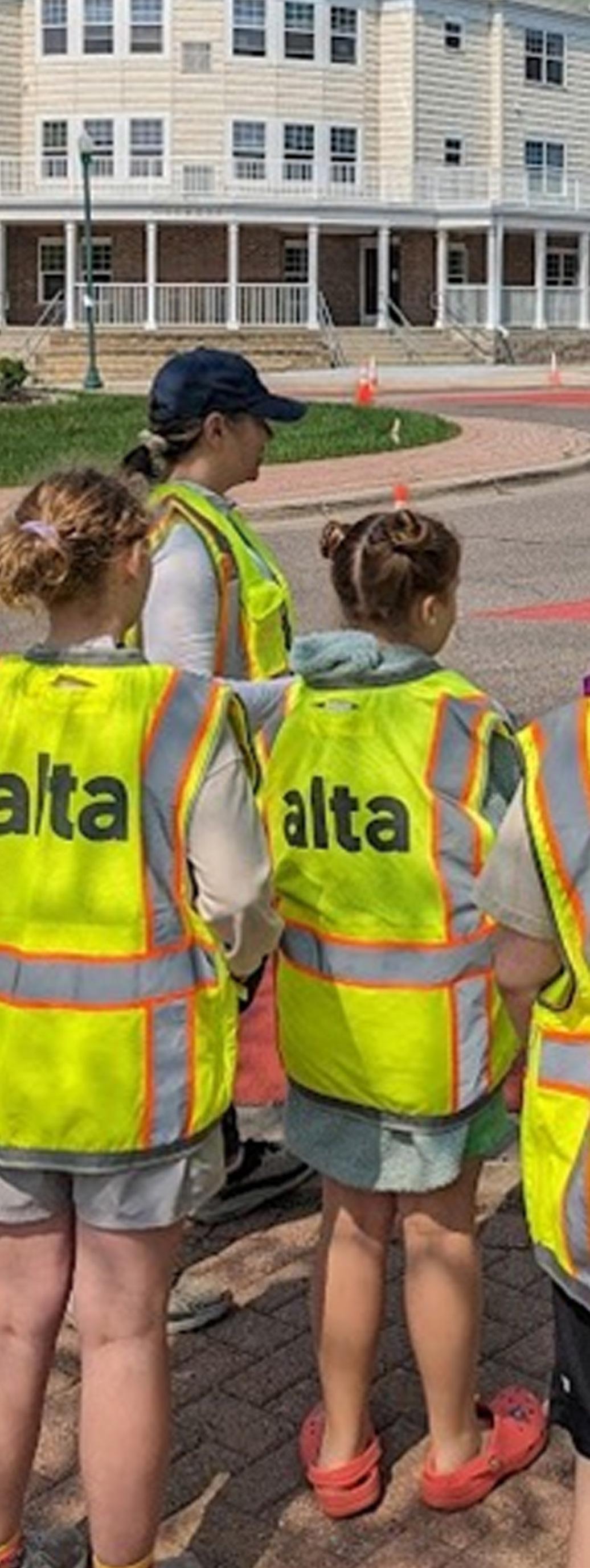

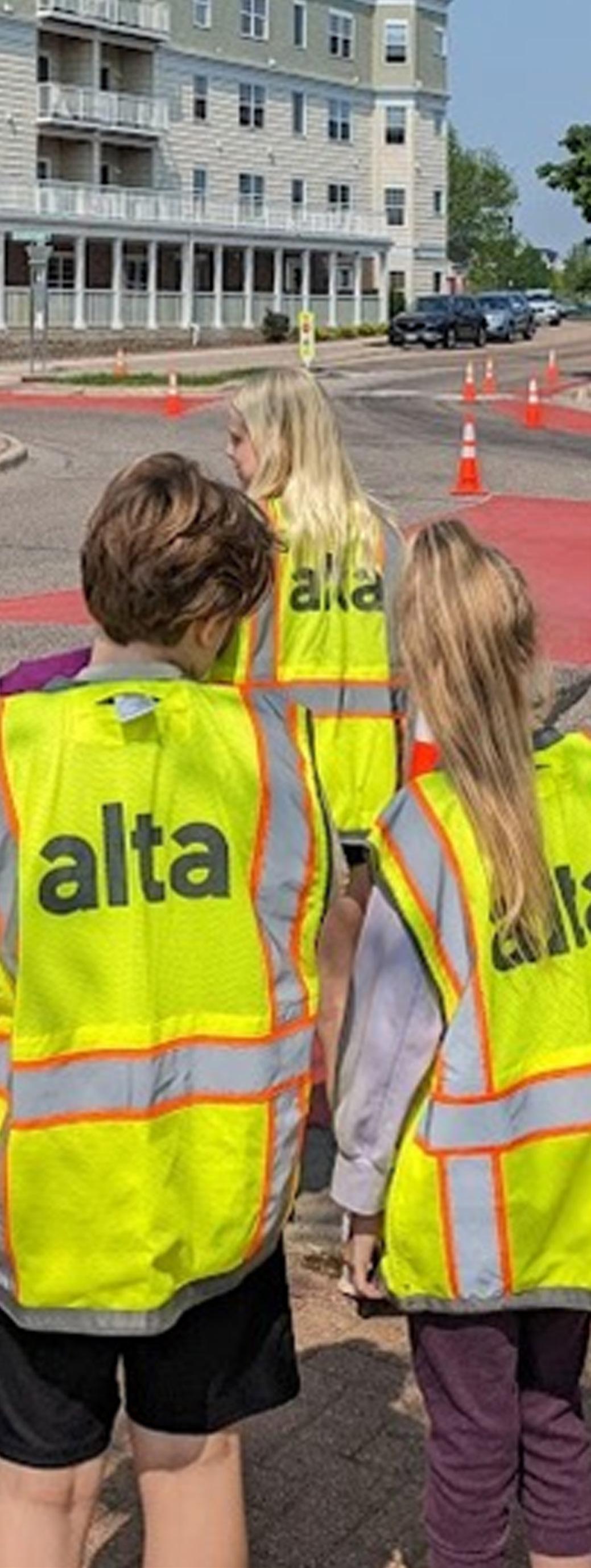
Alta specializes in helping communities make safety improvements for school children and families. Vision Zero efforts and Safety Action Plans provide leverage for supporting Safe Routes to Schools (SRTS) efforts through data, prioritization, and targeted safety interventions. Here are examples from communities that have brought a data-driven safety focus to SRTS, which highlights how other communities can leverage their own safety work:
3. 4.
The City of Tacoma, Wash., SRTS Action Plan 2024 Update uses Vision Zero data to prioritize schools and interweave these two programs
The Office of Education in San Mateo County, Calif., hired Alta to develop a Youth-Based High Injury Network, which identifies priority locations for planning assistance, as well as the most common causes of crashes to support communities in targeting interventions that address specific behaviors
Throughout Oregon, the Alta team provides train-the-trainer bicycle and pedestrian safety education to school children
In Minnesota, Alta works with local communities across the state to develop SRTS plans that identify projects ready for implementation, including low-cost demonstration projects that support safe walking and biking to school 1. 2.


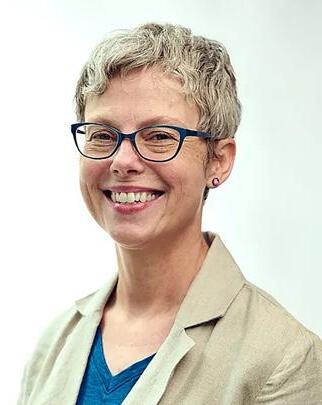
Katie Mangle Chief Strategy Officer katiemangle@AltaGo.com
Pacific Northwest Leader and Principal Katie Mangle has been promoted to Chief Strategy Officer (CSO) of Alta. With a career spanning nearly three decades in urban planning and sustainable transportation, Katie brings a wealth of experience and a visionary approach to her new role at the helm of the company’s strategic direction.
After 10 years at Alta, Katie’s path to CSO is a testament to her dedication and leadership skills. Before joining Alta, she held positions in both consulting and local government, gaining valuable insights into the intricacies of project management and cross-disciplinary collaboration.
Her experience as the leader of Alta’s sustainability and climate initiative was a pivotal moment in her career, broadening her perspective and influence across the company’s national operations.
In Katie’s new role, she will guide strategic growth, partnerships, and company initiatives. Her role will involve strong collaboration between Alta’s executive group, marketing team, and regional and strategic initiative leaders across the company.
With Katie at the strategic helm, Alta is poised for an exciting new chapter, reinforcing its commitment to sustainable transportation and community-focused solutions.

Ryan Sharp, PP, AICP
Principal and Safety Leader
ryansharp@AltaGo.com
Ryan Sharp, PP, AICP, joins Alta as Principal and Safety Leader. Ryan has dedicated his career to creating infrastructure that is truly safe for everyone regardless of how people move.
During Ryan’s recent work in the City of Hoboken, N.J., as the Director of Transportation and Parking, he had the vision to create and lead nationally celebrated Vision Zero and Complete Streets Programs. Ryan creatively and successfully implemented a substantial volume of safety improvements through these programs and provided the continuity needed to establish a safer street network for all road users. This led to the City of Hoboken’s incredible record of no traffic fatalities for seven straight years.
Having Ryan on the Alta team will expand the footprint of Alta’s national safety practice and will also allow us to continue to serve communities in Florida with passion, resolve, and commitment.

By Joce Pritchett, PE
DRMP is dedicated to more than just high-quality engineering solutions. Our focus is also on aligning projects with the values of the communities they serve.
A prime example of this commitment is the Project Development and Environment (PD&E) Study evaluating a proposed multi-use path along SR 30 (US 98) in Bay County, Fla. The Florida Department of Transportation (FDOT) selected DRMP to conduct the study, which combines public involvement and environmental stewardship into every
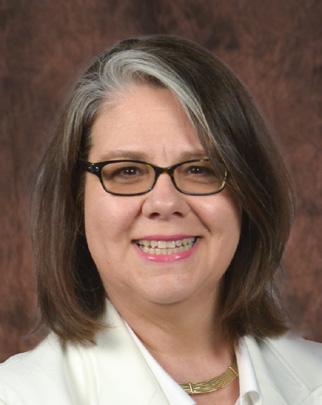
stage of project development.
The purpose of the US 98 Multi-Use Path Project is to improve regional and community connectivity with a 4.2-mile path along US 98, starting west of Mexico Beach city limits at Crooked Sound Drive as well as a segment extending from the US 98 and 15th Street intersection along 15th Street to the CR 386 intersection. The project will also improve bicycle and pedestrian safety, provide additional recreational benefits, and promote economic development. Read more about this project
Pd&E Division Leader jpritchett@drmp.com
Jocelyn “Joce” Pritchett, PE, serves as DRMP’s PD&E Division Leader and a Senior Project Manager for the firm’s Transportation Market Sector. She is responsible for managing and developing the company’s PD&E practice, including business plan development, project coordination and business development within the PD&E sector of practice throughout the Southeast region as well as serving as Project Manager on various NEPA and PD&E projects.
Her experience is in a range of projects, including widening and new-location of highways; bridges; area-wide and corridor studies; and transit projects for DOT and municipal clients in Mississippi, Georgia and Florida. Pritchett has extensive knowledge of procedural and substantive NEPA compliance, including project scoping, purpose and need, alternatives analysis, community studies, and environmental documentation, as applied by the Florida DOT PD&E Manual.

By Jim Highland, PE
Florida’s Turnpike Mainline stretches across 312 miles, traversing 11 counties within the state's peninsula, while the Turnpike Extension spans 47 miles.
The High-Pressure Sodium (HPS) lighting that illuminates the Turnpike, a familiar sight on many roadways, is antiquated and no longer being manufactured, making it difficult to repair and replace when necessary.

Jim W. Highland, PE
That is why Florida’s Turnpike Enterprise (FTE) has chosen DRMP as the prime consultant for the Districtwide HPS to Light-Emitting Diode (LED) Conversion Contract, which will convert 65.2 miles of roadway to modern LED lighting for Phase 1. This project marks the largest systemwide conversion in Florida and stands as one of DRMP’s most significant design accomplishments in our Traffic Department history. DRMP has offered Traffic Services since the 1980s.
Read more about this project
Vice President/Traffic Division Leader jhighland@drmp.com
Jim W. Highland, PE, serves as a Vice President and the Traffic Division Leader for DRMP’s Transportation Market Sector. He has managed various contracts for municipalities and the Florida Department of Transportation throughout his 20-year career. As a project manager, he is the main point of contact and handles task scoping, assigning team members to various projects, managing project schedules, budgets, and quality control. His experience in traffic engineering design has included technical engineering analysis, safety design and studies, design of minor intersection reconstruction, signalization plans, lighting plans and Intelligent Transportation Systems. He has experience performing traffic engineering studies, including signal warrants, midblock pedestrian crossing warrants, queue analysis, and analyzing traffic operations for intersections and corridors. drmp
1 (833) 811-3767

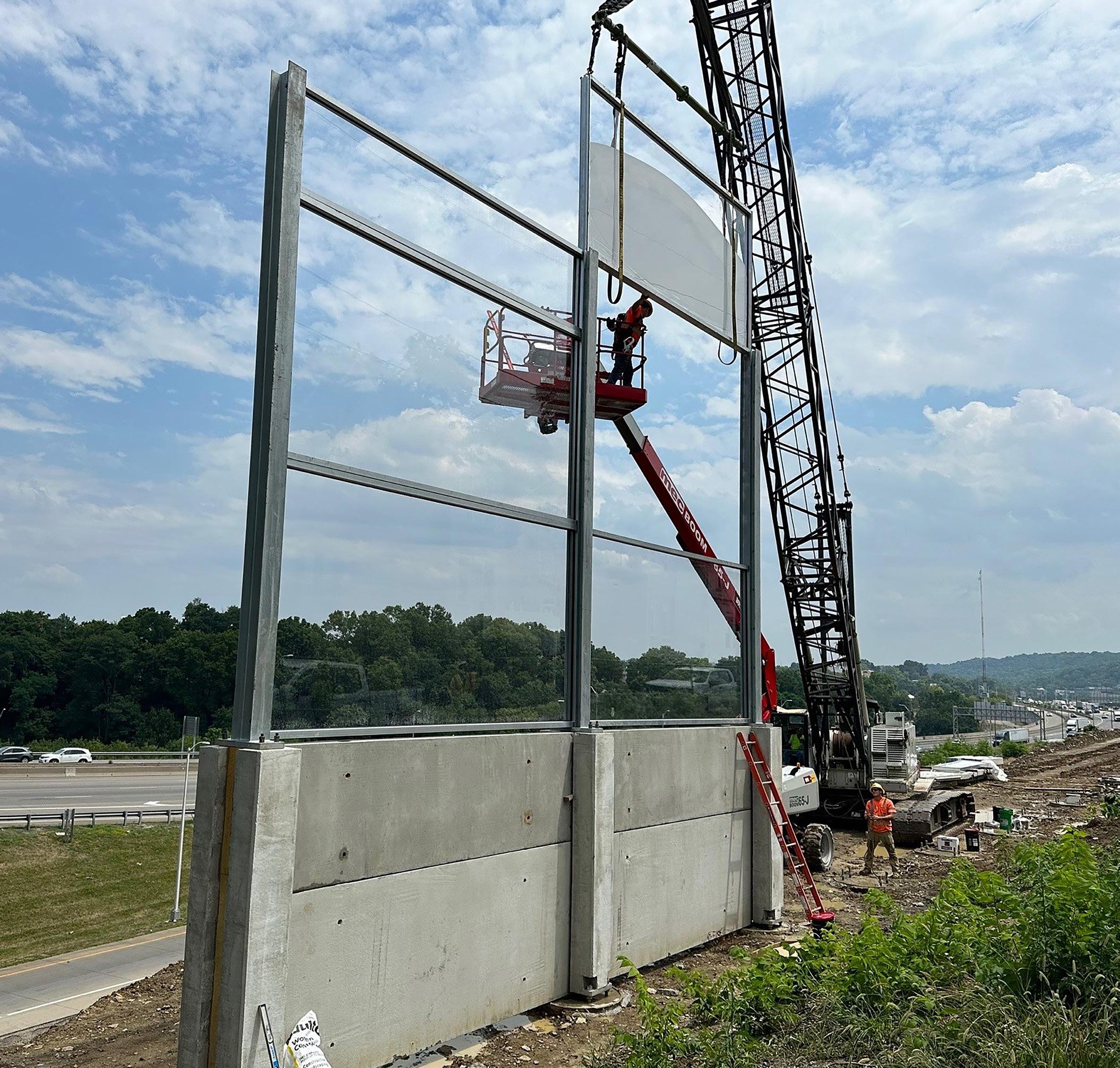
HMB Professional Engineers, Inc., headquartered in Frankfort, Ky., has been chosen as a prime consultant for the Kentucky Transportation Cabinet's Highway Safety Improvement Program (HSIP) in 2024. This selection marks a significant achievement for HMB, showcasing its expertise in civil engineering and commitment to enhancing transportation safety across Kentucky. This selection also signals HMB’s growth and capability in handling complex engineering challenges.
Established in its current form in 2015, the HSIP is a cornerstone of federal-aid programs aimed at reducing traffic fatalities and serious injuries on

public roadways. Funded through initiatives like SAFETEA-LU and the recent Infrastructure Investment and Jobs Act (IIJA), the program allocates approximately $58.5 million annually to Kentucky, with a 10 percent match requirement. Projects are meticulously selected based on priorities outlined in the Strategic Highway Safety Plan (SHSP) and a data-driven process that targets areas with high crash rates and specific crash types.
For this cycle, eight consultants/ teams have been chosen to serve in a prime role. While HMB's role as a prime consultant under the HSIP contract is new, HMB is no stranger to the HSIP program, serving as subconsultant on teams in the past. Work assignments originating from this contract encompass everything from initial planning and feasibility studies to final construction plans. Each project focuses on addressing critical safety issues such as roadway departures, intersection collisions, and pedestrian safety through innovative solutions like roundabouts, mini-roundabouts, and Restricted Crossing U-Turns (RCUTs).
A substantive factor in HMB’s selection to this contract is owed to the strategic hiring of Jennifer Hardwick, PE, RSP1 . Jennifer has a long history working with the
HSIP program and is respected by her peers for her innovative thinking, responsive client relationships, and impeccable organization.
“One of the most satisfying parts of my job is seeing a reduction in fatal and serious injury crashes following implementation of a project,” said Hardwick. “It means that our team was successful in identifying safety opportunities and developing improvements that helped Kentucky drivers get to their destinations safely."
Deanna Mills with the Kentucky Transportation Cabinet (KYTC) shared her feelings on Jennifer’s management style with HSIP. “Kentucky’s HSIP has an impressive group of consultant partners. Jennifer Hardwick rises to the top of that impressive group. She is reliable, responsive, and thorough. Her quality control is spot-on… In the five years I’ve worked with Jennifer, I’ve come to rely on her. She makes my job easier.”
HMB’s team members have already made significant contributions to various projects under the HSIP. For example, their involvement in the KY 84 Roadway Departure corridor in District 4 has aimed to enhance safety measures and mitigate crash risks along the stretch. In District 1, HMB played a key role in designing RCUT intersections aimed at reducing severe angle collisions, while the Goldburg roundabouts near Williamsburg, Ky., exemplify its innovative approach to improving traffic flow and safety.
HMB Professional Engineers, Inc., looks forward to continuing its partnership with the KYTC and fellow consultants to drive impactful changes in road safety across the state. By applying data-driven strategies and fostering community engagement, HMB remains steadfast in its mission to create safer and more efficient transportation systems for all Kentuckians.



Principal-in-Charge of the Environmental Division mleathers@hmbpe.com
Michael Leathers, PE, has spent 19 years at HMB and has exceled in a variety of complex roles. After a short period performing airport design, Michael joined HMB’s Remediation Division and served as Project Manager for over 200 UST sites. He then transitioned into roadway engineering, where his experience includes assisting the design manager in oversight of design for the Downtown Crossing of the Ohio River Bridges Project in Louisville. In 2015, Michael became Division Manager of HMB’s Environmental Group, where he oversees a diverse team of subject matter experts in various fields of environmental study. Michael's role in environmental has since expanded, and he now serves as principal-in-charge of the Environmental Division as well as HMB's new Cultural Resources Group.
Michael received his Bachelor of Science degree in Civil Engineering from the University of Kentucky followed by his Master of Business Administration degree from Campbellsville University. He was a participant in the 2013 class of ACEC’s “Leadership PE” and has been a trusted leader and “go-to” resource by the Kentucky Transportation Cabinet for over a decade.
Michael resides in Lebanon, Ky., with his wife, Amanda, and their three children.

Lora Boller, PE
Division Manager of the Structures Department lboller@hmbpe.com
Lora Boller, PE, joined HMB in 2021 and has been an invaluable asset to the company and its mission ever since. A native of Lawrenceburg, Ky., Lora is a recognized leader in her field, having served as State President of the Kentucky Chapter of NSPE from 2021-2022.
After joining HMB, she was quickly named Division Manager of the Structures Department and has been a driving force in its continuing success. With nearly 20 years of experience, Lora has developed a robust portfolio in structural engineering, bridge design, bridge inspection, and project management. Her extensive knowledge in hydraulics and hydrology has equipped her to handle a wide range of projects, from small culverts to multi-lane interstate bridges.
Lora earned her Bachelor of Science degree in Civil Engineering from Purdue University and went on to complete her Master of Science degree in Civil Engineering at the University of Kentucky shortly after. Outside of work, Lora enjoys spending time with her partner, Chico, and their 4-year-old son, Issac.

RDA provided professional engineering services serving as the Lead Designer for the I-95 at Temple Avenue Interchange Improvements Design-Build (DB) project. This project reconstructed the I-95 interchange at Temple Avenue to relieve congestion; enhance public safety, operations, and capacity; and accommodate forecasted traffic demand in the project area.
RDA was responsible for interchange/ roadway design, overall project management and Quality Assurance/ Quality Control, public involvement, utility relocation coordination and design, right of way acquisition services, environmental permitting, signing and marking plans, drainage/erosion and sediment, control/ stormwater management design, and subconsultant oversight/management.
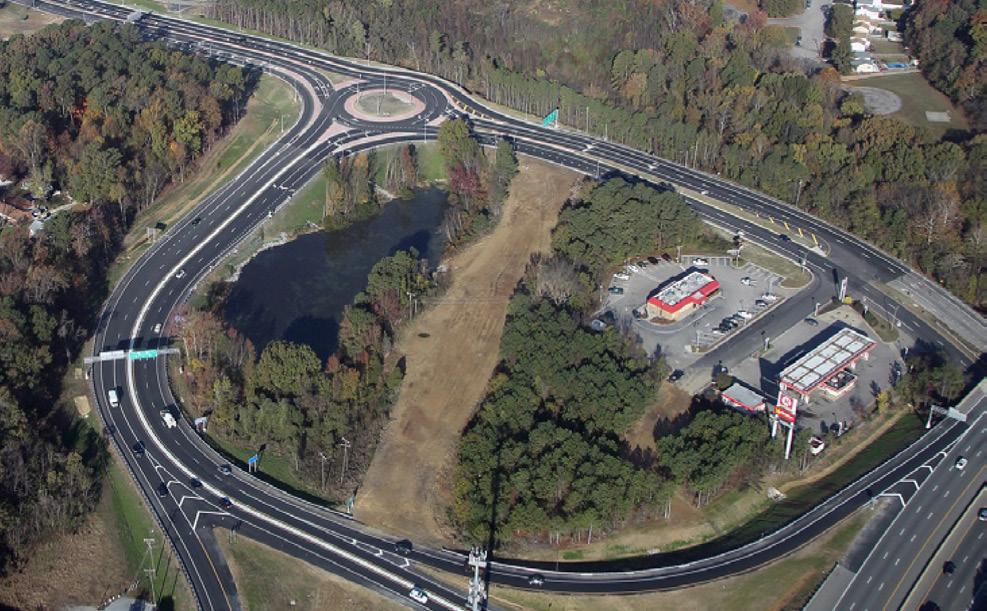
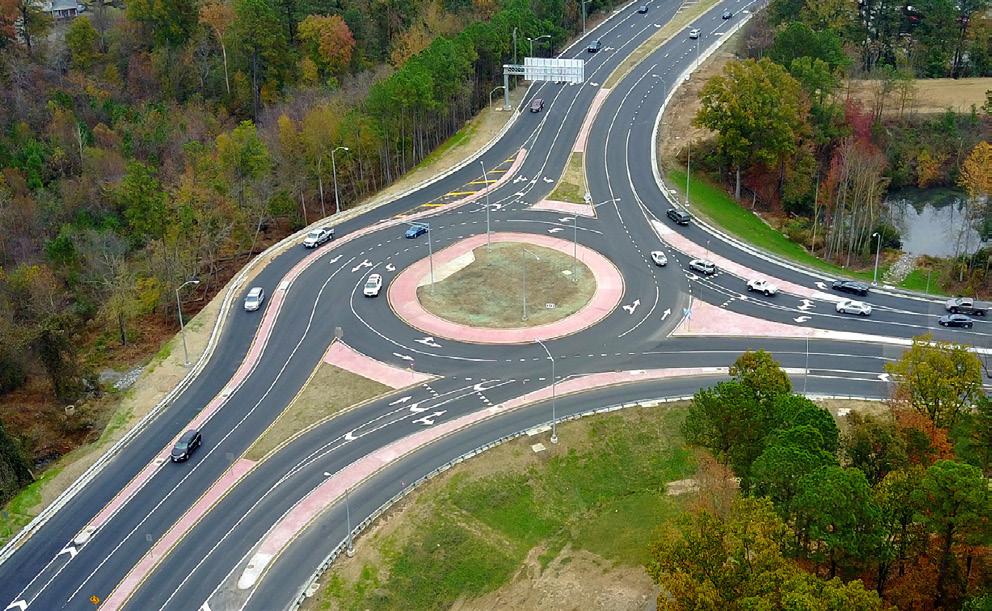

The success of the project was due in part to the successful implementation of innovative design solutions. To avoid stream and wetland impacts, RDA evaluated and designed a reinforced earth slope wall, which is typically not standard practice for Virginia Department of Transportation (VDOT) transportation projects, and therefore, required extensive coordination between the DB team, VDOT, and the wall manufacturer to achieve buy-in. Ultimately, our team was able to show the benefits of using a reinforced earth slope wall, which included schedule improvements, cost savings, reduced impacts on Maintenance of Traffic, and reductions in long-term maintenance costs.
Another challenge for the project was the need to maintain traffic while simultaneously removing two existing bridges over an abandoned railway and constructing the new roundabout in the same location. To facilitate removal of the first bridge, a temporary double wire wall was constructed and used to maintain traffic close to the existing grade of the roadway and facilitate tie-in with the adjacent lanes. The use of dual wire walls
tied together with a roadway on top to maintain the required number of lanes was unique. The height and width between the walls were approximately 21 feet, while the length was more than 200 feet for each wall, causing the walls to act as a column and adding additional analytical components to prove compliance, stability, and safety. After removal of the first bridge, fill was placed along one side of the double wire wall, and a permanent roadway was constructed on top. Traffic was shifted to the permanent roadway, the second bridge was removed,

fill was placed, and the double wire wall was buried at the required depth below finished grade of the completed roadway.
• 2018 ASHE National Project of the Year Under $20 million
• 2018 ENR Mid-Atlantic Award of Merit (Highway/Bridge)
• 2018 DBIA-MAR Honorable Mention
• 2020 VTCA "Design-Build" Winner of the VTCA Transportation Engineering Awards Program
Assistant Director of Transportation bshock@rdacivil.com
Brandon Shock, PE, DBIA, RDA's Assistant Director of Transportation, has 25 years of experience designing and managing major public transportation engineering projects at RDA. Based out of the Richmond, Va., office, he has been with RDA for over 17 years, specializing in design-build project delivery. He has supervised and served as the design lead for over 16 DB contracts with a total construction value of more than $5 billion. He also supervises various contracts in the central Virginia area for transportation infrastructure projects that include sidewalks/trails, safe routes to schools, and intersection and interchange improvements under the design-bid-build delivery method. These locality projects play a significant role in providing safety and mobility initiatives to the community while also increasing the quality of life for residents and visitors.

Fairfax County, Va.
Funded by Fairfax County local transportation improvement funds, the Burke Centre Virginia Rail Express (VRE) Connector Phase IV project provides a 900-foot-long, 8-footwide asphalt trail that connects north of Oak Bluff Court to the western terminus of Premier Court.
RDA, in association with the Fairfax County Department of Transportation, completed the design of the trail in accordance with the Americans with Disabilities Act requirements and local/ state standards and requirements. The new bicycle and pedestrian facility included a 715-foot-long, 5-footwide concrete sidewalk; a 375-foot-long retaining wall to minimize floodplain impacts; curb and gutter with new stormwater drainage inlets; parking modifications; and on-road bike lanes, signing, and pavement markings.
The project also provided concrete steps for the residents of Crevanna Oaks Apartments to connect to the asphalt trail. Special design consideration was taken to preserve a 90-inch culvert crossing to ensure that the proposed trail crossed the pipe at an elevation similar to the existing condition. Additionally, tree preservation collaborative efforts among county agencies helped to limit the number of trees impacted by construction.
The project team worked closely with adjacent property owners, businesses, and other stakeholders throughout the development of the project. Public meetings were held to offer stakeholders an opportunity to provide input on the proposed design and construction of the project.
The trail has seen extensive use since its opening to the public and has reduced traffic congestion and improved air quality in the area by reducing numerous vehicle trips.





•

John Cummings, PE, LEED AP (BD+C)
Director of Site Civil
jcummings@rdacivil.com
John Cummings, PE, LEED AP (BD+C) is a licensed engineer with 25 years of experience in site development. As RDA’s Director of Site Civil, John consistently demonstrates an ability to complete projects in a timely fashion and within set budget parameters. He is well versed in the design and permitting of submissions for various governmental agencies.
John has vast experience in various phases of site design, including site grading, typical section development, drainage design, erosion and sediment control, utility design, earthwork analysis, stormwater management (quality and quantity), parking lot design, and project cost estimating. His experience in managing projects includes project scheduling; utility relocation coordination; plan processing; public involvement assistance; bid document preparation; specifications; and assistance during construction including, progress reports and answering or creating Request for Information (RFIs), Potential Change Orders (PCOs), Architect's Supplemental Instructions (ASIs) etc.

Braking News is published quarterly as an internal communication to the employees of the Trilon Transportation Platform Partner Firms. Each partner firm contributes editorial content for the newsletter centered upon sharing project updates, services, leadership messages and industry news.
The newsletter cover photo in each issue will be provided by the partner firms in alphabetical order giving each firm an opportunity to showcase a service or project.
Managing Editor
Julia Lindstedt (DRMP)
Contributing Writers
Mackenzie Field (Alta Planning + Design)
Gabrielle Davis and Alexi Wyatt (DRMP)
Shawn Miller (HMB)
Ariel Peterson (Horrocks)
Hollis Sullivan, Darell Fischer and Aaron DeLong (RDA)
Graphic Design/Layout
Edmundo Rubio (DRMP)
Vision for Growth
To become a Top 5-10 transportation infrastructure consulting firm ($500m-$1bn+)
Opportunities to expand geographically and to broaden sub-markets (i.e., transit, aviation, goods movement, etc.)
• Substantial opportunity to capture share based on scale and potential investments
Spend expected to grow in the next few years as Infrastructure Investment and Jobs Act
Transportation End Market Segmentation (Based on Revenue)